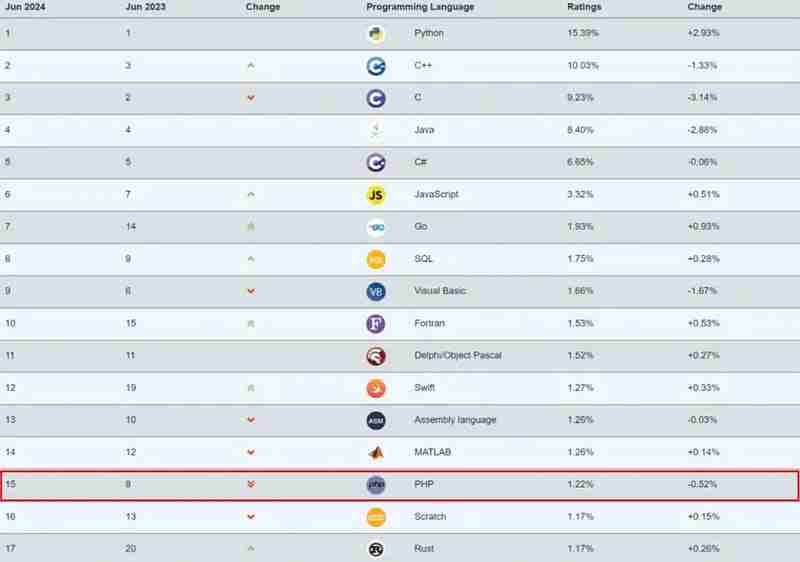 Backend Development
Backend Development
 PHP Tutorial
PHP Tutorial
 Is PHP Really Dead? Unveiling the Truth Through PHP's Evolution
Is PHP Really Dead? Unveiling the Truth Through PHP's Evolution
Is PHP Really Dead? Unveiling the Truth Through PHP's Evolution
In 1994, I was born in a small town in the United States. That same year, Canadian Rasmus Lerdorf created PHP. At the time, PHP was just a CGI script written in Perl. Perhaps by fate, PHP became my means of livelihood in the latter half of my life. Lerdorf’s original purpose for writing these scripts was simply to track visitors to his website. Thus, a simple beginning gave birth to “the best language in the world, PHP.” Great undertakings often have humble beginnings. These CGI scripts written in Perl can be seen as the prototype of PHP, even considered the first version, “PHP 1.0.”
This article is brought to you by ServBay — the next-generation web development environment that provides a fast, dependency-free, and non-intrusive installation solution for PHP/Node.js development environments. In just 3 minutes, you can have a complete development environment with a web server, database, email, DNS, and common tools, without needing Docker or source code compilation. Compatible with macOS 12 and above, supporting arm64 and x86_64 architectures, ServBay offers a high-performance and resource-saving development platform. Try ServBay and experience PHP 8.4!
Reportedly, the following code is from PHP’s first version. Does it look familiar to anyone?
html
<!--include /text/header.html--> <!--getenv HTTP_USER_AGENT--> <!--ifsubstr $exec_result Mozilla--> Hey, you are using Netscape!<p> <!--endif--> <!--sql database select * from table where user='$username'--> <!--ifless $numentries 1--> Sorry, that record does not exist<p> <!--endif exit--> Welcome <!--$user-->!<p> You have <!--$index:0--> credits left in your account.<p> <!--include /text/footer.html-->
That same year, Netscape released version 0.9 of the Navigator browser, the first mature web browser in history. Its release caused a sensation in the industry, providing fertile ground for the rapid development of PHP.

The following year, Rasmus Lerdorf released PHP 2.0. This version not only accessed databases but also embedded HTML to dynamically process data. These new features attracted a group of PHP enthusiasts, including Zeev Suraski and Andi Gutmans, who later joined the PHP core development team. The renowned “Zend VM engine” was led by these two developers.
By the end of 1998, instant messaging in the United States was on the rise, epitomized by AIM (AOL Instant Messenger). Around this time, the official version of PHP 3.0 was released. Its most compelling feature was its extensible modules, attracting numerous amateur developers to submit new extensions, laying a solid foundation for PHP’s ecosystem. The later emergence of the Swoole asynchronous communication extension also benefited from this.
Two years later, in the year 2000, right after the dot-com bubble burst, PHP 4.0 was released. This version introduced the Zend VM virtual machine engine written in C, significantly improving program execution performance. Additionally, it introduced support for classes and objects, marking the initial form of object-oriented features.
During the period of the “9/11” attacks in the United States in 2001, the open-source content management system WordPress v1.0, developed using PHP, was officially released. It was well-received by developers, significantly lowering the threshold for building blog websites. According to the latest statistics, WordPress’s market share has reached an astonishing 46%, making it the world’s most popular CMS. This means that about half of the websites on the internet are created using WordPress. It’s easy to imagine how WordPress’s popularity spurred the widespread adoption of PHP. I remember once rewriting WordPress source code, feeling overwhelmed by the procedural code, accustomed as I was to object-oriented programming. I wonder if other PHP developers have had similar experiences?

In 2004, the new era of PHP 5.0 was officially released, marking a significant milestone. Over the years, PHP iterated within the v5 version, making it the longest-lasting major version in PHP’s history. This version fully introduced object-oriented features and upgraded the Zend VM virtual engine to the second generation, significantly improving performance.
In 2007, three years after the release of PHP 5, the American PHP framework Laravel was born. Laravel’s release benefited many PHP developers. My first project was developed using Laravel, and I believe many PHP developers, like me, have benefited from this framework. However, the framework’s popularity further lowered the threshold for PHP development projects, attracting many people from non-professional backgrounds to switch to PHP development, leading to a mixed level of technical expertise among PHP developers today.

For a long time, PHP’s application scenarios were mainly concentrated on CMS content website construction, resulting in a lack of achievements in the field of asynchronous communication. It wasn’t until 2012 that Swoole released its first version. Although Swoole wasn’t perfect at first, it filled the gap in asynchronous network communication for PHP. This allowed PHP to shine in real-time communication, IoT communication, game development, and other fields, enhancing PHP’s development. That same year, Go language released its first version, v1.0, marking its maturity. Go is renowned for its high performance, whereas PHP has obvious shortcomings in this area, sowing the seeds for PHP developers to transition to Go language years later.

After more than a decade of iteration on the v5 version, PHP finally released PHP 7 at the end of 2015, marking a qualitative leap. Just as the reform and opening up significantly impacted China’s economy, PHP 7 had a similarly significant impact on PHP’s development history. Notably, Facebook engineer Sarah Goldman was one of the core initiators of PHP 7. PHP 7’s debut significantly improved Facebook’s system performance. Facebook’s early architecture used the LAMP stack, with PHP as the backend language. Many other platforms, like eBay and Wikipedia, also initially used PHP for development, proving PHP’s popularity at the time.

While we were still dealing with the COVID-19 pandemic and undergoing daily nucleic acid tests, PHP 8 was quietly released at the end of 2020. As a major update, its biggest highlight was the introduction of JIT (Just-In-Time) compilation technology. This technology allows PHP code to be compiled into machine code during execution, rather than being interpreted each time it runs. JIT compilation improves code execution efficiency, making PHP run faster with significant performance improvements. In short, PHP 8 injected strong momentum into the PHP ecosystem.
Today, although the pandemic has receded, its impact on the global economy persists, coupled with local unrest in some countries, leading to a continuous economic downturn. In this context, the internet industry is also facing challenges, with frequent layoffs in domestic internet companies, indirectly intensifying competition among programmers. The economy is like a cake; when it’s shrinking, there’s less to share. Programmers can’t expand outward, so they compete internally. Moreover, PHP has always been on the edge of the disdain chain, with developers of Java, C/C++, Go, and other languages considering their technologies superior. As a result, PHP developers are being squeezed out and forced to exit. I believe this is the real reason behind the perception that PHP is in decline.
Imagine if we could go back to the pre-pandemic era, with a booming global economy, a thriving internet industry, and flourishing small and medium-sized enterprises. In such a scenario, PHP would still dominate the programming language rankings and not fall out of the top ten. It is well-known that many renowned companies, both domestically and internationally, started with PHP, benefiting PHP-related practitioners immensely. Looking back, PHP’s contributions to the internet industry are enough to justify its nickname, “PHP is the best language in the world.”

I once saw a post on Reddit where a user expressed gratitude to PHP for the benefits it brought him. As a frontend developer, he was able to use PHP for backend development, taking on many outsourcing projects and earning substantial returns. However, someone retorted, saying that a lowly worker thanking a wrench is laughable. But I would argue that without the wrench, you might not even have the opportunity to screw bolts. Throughout PHP’s development, it has gradually met developers’ needs. Some languages come from prestigious backgrounds (e.g., Go language, created by the father of C language at Google), while others come from humble origins, leading to different growth paths and outcomes.

The era created Bill Gates, just as it did PHP. PHP 9 is still in development, and it is rumored to introduce native asynchronous programming with async/await, which will be a cutting-edge and efficient programming model for PHP. Finally, as the global economy gradually recovers and the internet industry continues to innovate, PHP will also rejuvenate. By maintaining its ease of use and flexibility while enhancing its performance, PHP is sure to firmly stand atop the web development world.
With many hands making light work, PHP developers should unite, weather the storm, and strive to build the PHP ecosystem. Let the voices claiming “PHP is dead” disappear, and bring PHP back to its peak.
The above is the detailed content of Is PHP Really Dead? Unveiling the Truth Through PHP's Evolution. For more information, please follow other related articles on the PHP Chinese website!

Hot AI Tools

Undresser.AI Undress
AI-powered app for creating realistic nude photos

AI Clothes Remover
Online AI tool for removing clothes from photos.

Undress AI Tool
Undress images for free

Clothoff.io
AI clothes remover

Video Face Swap
Swap faces in any video effortlessly with our completely free AI face swap tool!

Hot Article

Hot Tools

Notepad++7.3.1
Easy-to-use and free code editor

SublimeText3 Chinese version
Chinese version, very easy to use

Zend Studio 13.0.1
Powerful PHP integrated development environment

Dreamweaver CS6
Visual web development tools

SublimeText3 Mac version
God-level code editing software (SublimeText3)

Hot Topics
 1672
1672
 14
14
 1428
1428
 52
52
 1333
1333
 25
25
 1277
1277
 29
29
 1257
1257
 24
24
 Explain secure password hashing in PHP (e.g., password_hash, password_verify). Why not use MD5 or SHA1?
Apr 17, 2025 am 12:06 AM
Explain secure password hashing in PHP (e.g., password_hash, password_verify). Why not use MD5 or SHA1?
Apr 17, 2025 am 12:06 AM
In PHP, password_hash and password_verify functions should be used to implement secure password hashing, and MD5 or SHA1 should not be used. 1) password_hash generates a hash containing salt values to enhance security. 2) Password_verify verify password and ensure security by comparing hash values. 3) MD5 and SHA1 are vulnerable and lack salt values, and are not suitable for modern password security.
 How does PHP type hinting work, including scalar types, return types, union types, and nullable types?
Apr 17, 2025 am 12:25 AM
How does PHP type hinting work, including scalar types, return types, union types, and nullable types?
Apr 17, 2025 am 12:25 AM
PHP type prompts to improve code quality and readability. 1) Scalar type tips: Since PHP7.0, basic data types are allowed to be specified in function parameters, such as int, float, etc. 2) Return type prompt: Ensure the consistency of the function return value type. 3) Union type prompt: Since PHP8.0, multiple types are allowed to be specified in function parameters or return values. 4) Nullable type prompt: Allows to include null values and handle functions that may return null values.
 PHP and Python: Different Paradigms Explained
Apr 18, 2025 am 12:26 AM
PHP and Python: Different Paradigms Explained
Apr 18, 2025 am 12:26 AM
PHP is mainly procedural programming, but also supports object-oriented programming (OOP); Python supports a variety of paradigms, including OOP, functional and procedural programming. PHP is suitable for web development, and Python is suitable for a variety of applications such as data analysis and machine learning.
 PHP and Python: Code Examples and Comparison
Apr 15, 2025 am 12:07 AM
PHP and Python: Code Examples and Comparison
Apr 15, 2025 am 12:07 AM
PHP and Python have their own advantages and disadvantages, and the choice depends on project needs and personal preferences. 1.PHP is suitable for rapid development and maintenance of large-scale web applications. 2. Python dominates the field of data science and machine learning.
 How do you prevent SQL Injection in PHP? (Prepared statements, PDO)
Apr 15, 2025 am 12:15 AM
How do you prevent SQL Injection in PHP? (Prepared statements, PDO)
Apr 15, 2025 am 12:15 AM
Using preprocessing statements and PDO in PHP can effectively prevent SQL injection attacks. 1) Use PDO to connect to the database and set the error mode. 2) Create preprocessing statements through the prepare method and pass data using placeholders and execute methods. 3) Process query results and ensure the security and performance of the code.
 PHP: Handling Databases and Server-Side Logic
Apr 15, 2025 am 12:15 AM
PHP: Handling Databases and Server-Side Logic
Apr 15, 2025 am 12:15 AM
PHP uses MySQLi and PDO extensions to interact in database operations and server-side logic processing, and processes server-side logic through functions such as session management. 1) Use MySQLi or PDO to connect to the database and execute SQL queries. 2) Handle HTTP requests and user status through session management and other functions. 3) Use transactions to ensure the atomicity of database operations. 4) Prevent SQL injection, use exception handling and closing connections for debugging. 5) Optimize performance through indexing and cache, write highly readable code and perform error handling.
 PHP's Purpose: Building Dynamic Websites
Apr 15, 2025 am 12:18 AM
PHP's Purpose: Building Dynamic Websites
Apr 15, 2025 am 12:18 AM
PHP is used to build dynamic websites, and its core functions include: 1. Generate dynamic content and generate web pages in real time by connecting with the database; 2. Process user interaction and form submissions, verify inputs and respond to operations; 3. Manage sessions and user authentication to provide a personalized experience; 4. Optimize performance and follow best practices to improve website efficiency and security.
 Choosing Between PHP and Python: A Guide
Apr 18, 2025 am 12:24 AM
Choosing Between PHP and Python: A Guide
Apr 18, 2025 am 12:24 AM
PHP is suitable for web development and rapid prototyping, and Python is suitable for data science and machine learning. 1.PHP is used for dynamic web development, with simple syntax and suitable for rapid development. 2. Python has concise syntax, is suitable for multiple fields, and has a strong library ecosystem.



